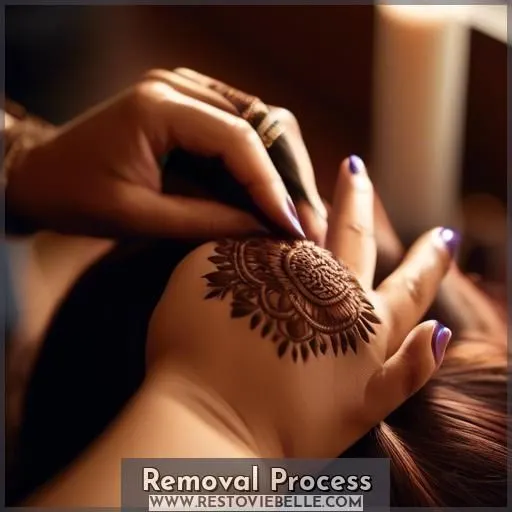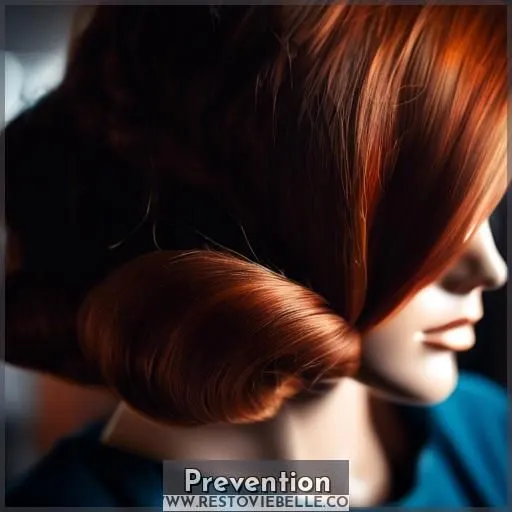This site is supported by our readers. We may earn a commission, at no cost to you, if you purchase through links.

To remove henna dye from your hair, start by using a clarifying shampoo, followed by a sulfate-free cleansing product or co-wash. For stubborn cases, try an oil treatment with extra virgin olive, argan, or unrefined coconut oil, applied from root to tip and left overnight. Repeat this every 3-4 days for gradual lightening.
Avoid using hydrogen peroxide, as it can severely damage your hair. Remember, any method used to remove henna can be harsh, so it’s best to consult a professional hairstylist before attempting at-home solutions.
Table Of Contents
Key Takeaways
- Start with a clarifying shampoo to remove henna, followed by a sulfate-free cleansing product or co-wash.
- For stubborn cases, try an oil treatment with extra virgin olive, argan, or unrefined coconut oil, applied from root to tip and left overnight.
- Avoid using hydrogen peroxide, as it can severely damage your hair.
- Consult a professional hairstylist before attempting at-home solutions.
How to Remove Henna From Hair?
To remove henna from your hair, follow these steps:
- Apply oil to your hair: Cover your hair with mineral oil, olive oil, or a blend of oils like olive, coconut, and argan oil. Massage the oil from your roots to your tips and along your scalp until your hair is dripping with oil.
- Cover your hair: Wrap your hair with plastic wrap or a plastic shower cap and leave it covered for at least 2-3 hours.
- Shampoo your hair: Wash your hair with a clarifying shampoo to remove the oil. If oil doesn’t work, try applying alcohol or something acidic, like lemon juice or honey, to strip the henna from your hair.
- Use peroxide or hair dye: If the above methods don’t work, you can try using peroxide or hair dye to remove the henna. Be cautious, as these methods could potentially damage your hair.
Understanding Henna Dye
Henna dye is a popular choice for those seeking a natural hair coloring alternative. It offers a range of benefits, including a rich auburn hue that can last longer than traditional chemical dyes. Henna is also rich in antioxidants, proteins, and has an antifungal effect, which can be beneficial for scalp health. However, be aware of the potential risks associated with henna, such as the possibility of damaging hair when combined with bleach.
In recent years, there’s been a growing demand for healthier hair services due to the green movement, which has led to an increased interest in natural hair coloring methods like henna. If you’re considering using henna, being informed about its characteristics and removal process is key.
Removal Process
If you’re ready to remove the henna dye from your hair, there are several methods to choose from. One popular approach involves using clarifying shampoo. Apply a high-powered clarifying shampoo to your hair twice, massaging it into your scalp before wetting your hair. Rinse thoroughly and repeat if necessary.
Another option is to apply vodka to your hair and leave it on for 15 minutes before rinsing. For a gentler approach, try using a sulfate-free cleanser or co-wash.
If you’re considering more extreme measures, be aware that hydrogen peroxide can severely damage your hair while removing the henna dye. Additionally, herbal dyes and chemical-free hair coloring may cover henna dye better than traditional dyes.
Oil Treatment for Removal
To remove henna dye from your hair, you can use a combination of oils. Apply equal parts of extra virgin olive oil, argan oil, and unrefined coconut oil to your hair from root to tip. Cover your hair with a shower cap or plastic wrap and leave the oil in overnight.
In the morning, shampoo your hair with a sulfate shampoo to remove the oil and henna. Follow up with a co-wash or gentle sulfate-free cleanser to make sure all the oil is removed.
Frequency and Timeline
When tackling henna removal, patience is your new best friend. Here’s the lowdown:
- Oil Treatment: Your hair’s spa day—soak it in a nourishing oil blend every three to four days.
- Natural Lightening: Gradual fading is the name of the game; think of it as color correction in slow motion.
- Growing Out: Embrace the journey; your hair’s history is just growing out with style.
Prevention
If you suspect that you might want to remove henna from your hair in the future, it’s prudent to abstain from using it entirely. Remember that any method employed to remove henna has the potential to harm your hair, so it’s essential to consult a professional hairdresser before trying any home remedies.
Visit a Professional Before Attempting At-home Solutions
Regarding henna dye removal from hair, it’s essential to obtain expert guidance. Home remedies can present hazards, including hair deterioration. A salon offers a more secure setting where specialists can assist you throughout the procedure. They can suggest effective and risk-free techniques for eliminating the plant-based hair dye, safeguarding the health and radiance of your hair.
Avoid jeopardizing your hair’s future for a rapid solution. Seek professional advice for henna removal and prioritize removing the dye in a controlled, secure manner.
Any Method Used to Remove Henna Can Damage Hair
Any method employed to eliminate henna dye can impair your hair. Henna is an enduring color that numerous salons will refrain from dyeing over. If you’re contemplating removing henna, it’s imperative to grasp the potential hazards. Here are three aspects to bear in mind:
- Bleach Penetration: Henna hinders bleach penetration, thus if you intend to lighten your hair, you may need to trim it short or bide your time until the henna subsides naturally.
- Oxidative Dyes: If you’re employing henna with metallic salts, be apprised that these substances can interact with oxidative dyes, potentially instigating heat and hair damage.
- Green Movement: The green movement is escalating the demand for more salubrious hair services, so deliberate opting for milder methods such as oil treatments or awaiting the henna to fade before implementing drastic alterations.
Frequently Asked Questions (FAQs)
What is the best way to remove henna from hair?
Removing henna is like peeling off old paint – it takes elbow grease, but with the right tools, you’ll have vibrant, henna-free locks in no time. Start by saturating your hair in a nourishing oil blend, then give it a thorough clarifying cleanse.
Can I use a clarifying shampoo to remove henna?
Yes, you can use a clarifying shampoo to help remove henna from your hair. Start by shampooing twice, then follow up with a moisture-restoring treatment. Be patient – it may take a few rounds to fully strip the dye.
How long does it take for henna to fade completely?
Henna can take up to 2 months to fully fade from your hair. Be patient – it may be a slow process, but you’ll be back to your natural color in no time.
Can I use a color stripper to remove henna?
Trying to strip henna with color removers is like wielding a sledgehammer to remove a splinter – it may work, but the collateral damage could leave your hair in tatters. Patience and gentle, oil-based treatments are your best bet for safely fading that stubborn color.
Is it safe to bleach hair with henna in it?
Bleaching hair with henna isn’t recommended – it can cause severe damage. The chemical reactions can lead to hair breakage, discoloration and even loss. It’s wise to consult a professional to safely remove henna-dyed hair.
Conclusion
Ultimately, removing henna from your hair can be a delicate process. With the right approach, you can bid farewell to the stubborn dye. Remember, patience is key, and consulting a professional stylist is highly recommended to avoid any potential damage.
Embrace the journey of reviving your natural hair color, and you’ll be on your way to a fresh, henna-free look in no time.










